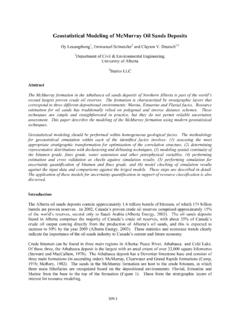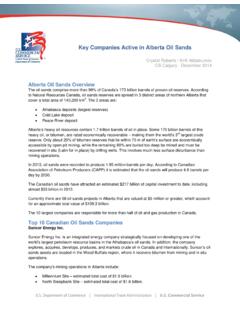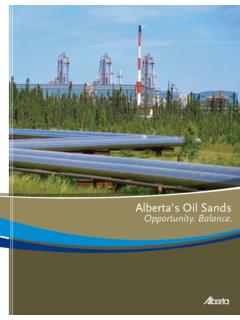Transcription of A Review of Cogeneration in Alberta - OSCA
1 1 Analysis and Results prepared for: Oil Sands Community Alliance (OSCA) Unit 617, 8600 Franklin Avenue Fort McMurray, Alberta T9H 4G8 A Review of Cogeneration in Alberta Issued: September 29, 2015 A Review of Cogeneration in Alberta (September 2015) 1 Disclaimer The information and data provided in this report has been obtained or prepared from sources that are believed to be reliable and accurate but has not necessarily been independently verified. EDC Associates Ltd. makes no representations or warranties as to the accuracy or completeness of such information and data nor the conclusions that have been derived from its use. Further, the data in this report is generally of a forecast nature and is based on what are believed to be sound and reasonable methodologies and assumptions, however cannot be warranted or guaranteed with respect to accuracy. Therefore, any use of the information by the reader or other recipient shall be at the sole risk and responsibility of such reader or recipient.
2 The information provided in this report and the facts upon which the information is based as well as the information itself may change at any time without notice subject to market conditions and the assumptions made thereto. EDC Associates Ltd. is under no obligation to update the information or to provide more complete or accurate information when it becomes available. EDC Associates Ltd. expressly disclaims and takes no responsibility and shall not be liable for any financial or economic decisions or market positions taken by any person based in any way on information presented in this report, for any interpretation or misunderstanding of any such information on the part of any person or for any losses, costs or other damages whatsoever and howsoever caused in connection with any use of such information, including all losses, costs or other damages such as consequential or indirect losses, loss of revenue, loss of expected profit or loss of income, whether or not as a result of any negligent act or omission by EDC Associates Ltd.
3 Copyright EDC Associates Ltd., 2015 This document was prepared under contract by EDC Associates Ltd. and may not be copied or reproduced, translated to electronic media in any form or manner whatsoever, in whole or in part, nor distributed to any third party without the prior written consent of EDC Associates Ltd. EDC Associates Ltd. Suite #310, 505-8th Avenue SW Calgary, AB T2P 1G2 EDC Associates Ltd. A Review of Cogeneration in Alberta (September 2015) 2 Table of Contents Executive Summary & Conclusions .. 3 Introduction to Cogeneration .. 4 Deployment of Cogeneration in Alberta .. 6 Benefits of Cogeneration .. 11 Risks & Barriers to Cogeneration .. 16 Qualifications .. 18 Appendix 1 CV s of Contributing Personnel .. 20 List of Figures Figure 1 Cogeneration Configuration .. 4 Figure 2 - Source of 2014 Steam Production for In-Situ Oil Sands Projects .. 6 Figure 3 - Ordered List of Current Alberta Cogeneration Plants.
4 7 Figure 4 - Current Alberta Cogeneration Market Share by Industry .. 8 Figure 5 - Progression of OSCA Expected Cogeneration Capacity (MW) .. 9 Figure 6 Cogeneration Potential in Balancing to Electricity Needs or Steam Needs .. 10 Figure 7 - Comparison of Typical Oil Sands Cogen & Boiler Costs .. 11 Figure 8 - Comparison of Range of Emission Intensities by Fuel Type .. 12 Figure 9 - Alberta 2014 Capacity Factors by Fuel Type .. 14 Figure 10 Generation Comparative Levelized 15 EDC Associates Ltd. A Review of Cogeneration in Alberta (September 2015) 3 Executive Summary & Conclusions Cogeneration currently has the lowest levelized cost for new generation, given the re-use of the waste heat to produce useful by-product steam. The fuel, natural gas, is produced locally, in abundance at low cost with a corresponding royalty benefit to the crown. The benefits of Cogeneration can be segmented into four categories: 1) Improved efficiency and reduced emission intensity for generation of steam and electricity.
5 2) Improved life-cycle economics (under appropriate market conditions) to produce steam and electricity. 3) Increased reliability for oil sands project (own generation capacity) 4) Potential additional margin from the sale of low-cost excess power to the Alberta electricity grid. In addition to the benefits which accrue to Cogeneration owners, Cogeneration also provides an additional and diverse source of electricity capacity to the overall Alberta grid. Despite its many benefits, only an estimated 16% of the total oil sands steam requirements is being produced through Cogeneration . Developers of Cogeneration face a number of challenges that have impeded it from reaching its full potential. Some are related to market fundamentals, like the uncertainty of future prices of natural gas and electricity. Others arise from individual development policies at the corporate level, including access to the incremental capital that Cogeneration requires versus steam boilers.
6 Finally, government policy makers can play a decisive role in enabling and encouraging fulsome development of Cogeneration , such as providing timely clarity on future greenhouse gas emissions compliance obligations, reducing barriers and development timelines for the connection and approval process, and ensuring adequate transmission capacity is developed on time for industry requirements. The perceived and real risks and issues outlined above have overshadowed the significant economic benefits of Cogeneration such that Alberta may have foregone efficiency and environmental benefits. EDC Associates Ltd. A Review of Cogeneration in Alberta (September 2015) 4 Introduction to Cogeneration In the early 1990 s, Alberta began to deregulate its once vertically integrated cost-of-service regulated electric utility sector, creating an environment more conducive to industrial customers building behind the fence generation, largely in the form of Cogeneration .
7 Cogeneration (cogen) technology is well established and has been deployed in the industrial sector of North America in its current forms for over 30 years. Efficiency gains in the technology have greatly improved with the continued advancement in aero-derivative turbine technology. Capital costs and delivery times have similarly improved with packaged systems. Historically, the Alberta industrial sector has consumed approximately 65% of the electricity produced in the province, with much of the incremental growth in electricity demand coming from the oil sands sector. Oil sands projects (especially SAGD) have a significant demand for process steam, mostly used to produce high viscosity bitumen out of the ground. Even more so in these low oil-price times, bitumen producers are motivated to find the most reliable and economic source for both electricity and steam, creating the perfect environment and host for cogen.
8 In a cogen, natural gas is burned directly at the blades of a gas combustion turbine, which spins a generator to make electricity. The extremely hot exhaust gases are passed through a Heat Recovery Steam Generator (HRSG, pronounced her-sig ), which converts the waste heat to steam. Most facilities also employ additional duct firing in the HRSG to generate additional process steam at optimal efficiencies. The steam is then put to work in its host s process, displacing steam otherwise produced by a traditional standalone steam boiler. Simultaneously creating electrical energy and steam energy is much more efficient (90%) and economic over the life-cycle than making the two separately (54% and 85% efficiency respectively). Figure 1 Cogeneration Configuration The level of Cogeneration investment can be described at three general levels: 1. No Cogeneration . Buy all electricity from the grid and produce steam through steam boilers.
9 Many small oil sands plants use no Cogeneration , since they have less opportunity to capture certain economies of scale for such things as the connection and fixed operating costs of running the generator. 2. Match the size of Cogeneration to the expected electricity use and complement the remaining steam demand with traditional steam boilers. 3. Match the size of Cogeneration to the level of on-site steam required and sell excess electricity to the grid. When a Cogeneration project is sized to meet the thermal load requirements of the heat-Heat Recovery Steam GeneratorWaste HeatHot Exhaust GasHigh Pressure Steam to another ProcessCombustion Gas TurbineGeneratorGasExtra Duct Firing Gas EDC Associates Ltd. A Review of Cogeneration in Alberta (September 2015) 5 intensive oil sands extraction process, the facility produces electricity greatly in excess of its own requirements ( , Shell Carmon Creek, in its fully developed 3-unit configuration (600 MW), may produce three times as much electricity as it will consume behind the fence.)
10 MEG Energy Christina Lake produces up to 5 times as much electricity as it uses on site). Each site owner uses its own set of criteria to set the level of Cogeneration capacity development. Each company has different access to expertise and experience in evaluating, constructing, operating, selling excess electricity and integrating cogens into their core business, so have a greater or lesser degree of corporate comfort. Each company has different access to and strategy for allocating capital, different risk tolerance and natural hedging opportunities, different levels of understanding of the fundamentals of electricity and even different approaches to environmental impact compliance. EDC Associates Ltd. A Review of Cogeneration in Alberta (September 2015) 6 Deployment of Cogeneration in Alberta In Alberta , the Cogeneration fleet has grown rapidly from the turn of the millennium, as both Suncor and Syncrude significantly expanded production of their oil sands mining operations and both installed Cogeneration in excess of their own needs.












